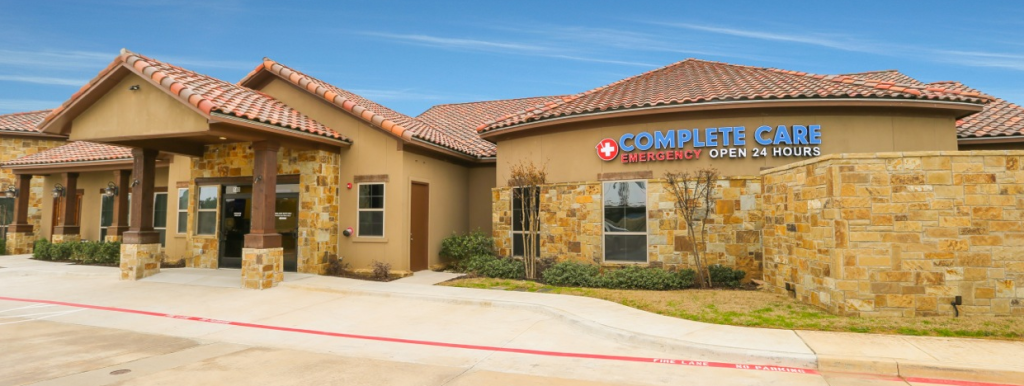When to Go to the ER for Symptoms of Pneumonia
Cold & Flu
•
Apr 1, 2025
Reviewed by: Jeffrey Peebles, M.D

While most cases of pneumonia can be treated at home or through your primary care physician, certain severe symptoms of pneumonia require immediate emergency care. Being able to recognize these warning signs can allow you to get timely, potentially life-saving treatment.
Seek emergency care immediately if you experience:
- Severe difficulty breathing or shortness of breath that makes it hard to speak or catch your breath
- Chest pain that is severe or worsens when breathing or coughing
- A bluish tint to your lips, fingernails, or skin, indicating low oxygen levels
- High fever above 103°F (39.4°C), especially when accompanied by confusion or severe fatigue
- Coughing up significant amounts of blood
When these severe symptoms arise, every minute counts. Each of Complete Care’s freestanding ER locations provides the same level of emergency care as hospital-based ERs, but often with shorter wait times and more personalized attention — variables that can make all the difference when you’re suffering from these severe symptoms with pneumonia.
For life-threatening situations, please call 911.
Severe difficulty breathing or shortness of breath
When pneumonia infects your lungs, it causes inflammation and fluid buildup in the tiny air sacs (alveoli) where oxygen normally enters your bloodstream. This is why many people wonder, “When should I worry about my pneumonia?” — and severe breathing difficulty is a key warning sign. The infection makes these air sacs less efficient at transferring oxygen, forcing you to work harder to breathe.
You might notice yourself breathing faster than usual, feeling unable to catch your breath even when resting, or struggling to complete sentences without pausing for air. Unlike milder lung infection symptoms, severe shortness of breath from pneumonia often makes simple activities like walking to the bathroom or climbing stairs feel impossible. If you’re experiencing this level of breathing difficulty, you shouldn’t wait to seek emergency care.
Chest pain that is severe or worsens when breathing or coughing
The inflammation from pneumonia can irritate the pleura, the membrane that surrounds your lungs. While some chest discomfort is common with symptoms with pneumonia, severe or worsening chest pain requires immediate attention. This pain might feel sharp, stabbing, or like a tight band around your chest, especially when you breathe deeply or cough.
Many people ask, “Should I go to the ER or urgent care for pneumonia?” when experiencing chest pain. While urgent care can handle mild cases, severe chest pain needs emergency evaluation to rule out complications. This is particularly important because pneumonia can sometimes occur alongside other respiratory conditions like RSV or develop from an upper respiratory infection (URI).
A bluish tint to your lips, fingernails, or skin
When your blood isn’t carrying enough oxygen due to severe pneumonia, it can cause a condition called cyanosis, in which your skin and mucous membranes take on a bluish color. This is different from the mild paleness you might see with walking pneumonia symptoms and represents a serious emergency requiring immediate medical attention.
Think of this discoloration as your body waving a huge red flag. It often appears first in areas with thinner skin like your lips, fingernails, and earlobes. While cyanosis may look distinctly blue on lighter skin, it can present as a gray or whitish tone on darker skin, or the lips and nail beds may appear darker or purplish — making it especially important to check these areas closely.
High fever above 103°F (39.4°C)
A high fever is your body’s aggressive response to fighting the pneumonia infection. While lower-grade fevers are common with respiratory infections, a temperature above 103°F signals that your body is working extremely hard — perhaps too hard — to battle the infection. This is especially concerning when fever appears suddenly or persists despite taking fever-reducing medications.
When patients ask about symptoms of bronchitis versus pneumonia, persistent high fever is a key differentiator. High fevers with pneumonia can sometimes cause confusion, weakness, or even left side abdominal pain due to the body’s inflammatory response. These symptoms combined with such a high temperature warrant immediate emergency evaluation.
Learn more: When to go to the ER for bronchitis
Coughing up significant amounts of blood
Coughing up blood (hemoptysis) occurs when the infection damages the small blood vessels in your lungs. While small streaks of blood in mucus might occur with severe coughing, coughing up significant amounts of blood indicates potential serious damage to your lung tissue and requires immediate emergency care.
Symptoms like this are particularly alarming for a reason, and should never be ignored. The amount of blood, its color, and whether it’s mixed with mucus can all provide important diagnostic information to emergency physicians. If you’re coughing up blood, especially if it’s more than a few drops, it’s crucial to seek emergency care right away to prevent potential complications.
Symptoms of pneumonia — FAQs
What are the four stages of pneumonia?
The four stages of pneumonia are:
- Congestion: hours 1-24, when the lungs become heavy with fluid
- Red hepatization: days 2-3, when red blood cells and immune cells enter the air spaces
- Gray hepatization: days 4-6, when fibrin deposits accumulate
- Resolution: days 7-10, when the infection clears and normal lung function returns
Each stage represents distinct changes in the lungs as your body fights the infection and begins healing.
Will pneumonia clear up on its own?
While mild cases of bacterial pneumonia may improve without treatment, attempting to recover without medical care can be dangerous and lead to serious complications. Most cases of pneumonia require appropriate antibiotics or antiviral medications, along with supportive care, to ensure proper recovery and prevent the infection from worsening.
What will the ER do for pneumonia?
In the ER, doctors will typically start by checking your vital signs, oxygen levels, and performing chest X-rays to confirm the diagnosis and severity of your pneumonia. They may then provide treatments, including IV antibiotics, oxygen therapy if needed, breathing treatments to help open your airways, and IV fluids for hydration, depending on your specific condition and symptoms.
Complete Care’s freestanding ERs — where respiratory emergencies meet rapid response
When symptoms of pneumonia become severe — whether it’s struggling to catch your breath, experiencing intense chest pain, running a high fever, or noticing a bluish tint to your skin — every minute matters in getting the care you need.
With state-of-the-art facilities in Austin, Corpus Christi, Dallas/Fort Worth, East Texas, Lubbock, San Antonio, and Colorado Springs, Complete Care ensures that top-tier emergency medical care is always close to home.
Our emergency-trained physicians and advanced diagnostic capabilities mean you’ll receive the same level of care as a hospital-based ER but with shorter wait times and more personalized attention. Don’t wait until symptoms become life-threatening, trust Complete Care to provide the rapid response you need for respiratory emergencies.
More Helpful Articles by Complete Care:
- How to Get Rid of an Abscess
- What Happens if a Hernia is Left Untreated?
- When Should You Be Worried About Flank Pain?
- How to Reduce High Blood Pressure
- Why Do I Feel Sick After Traveling?
